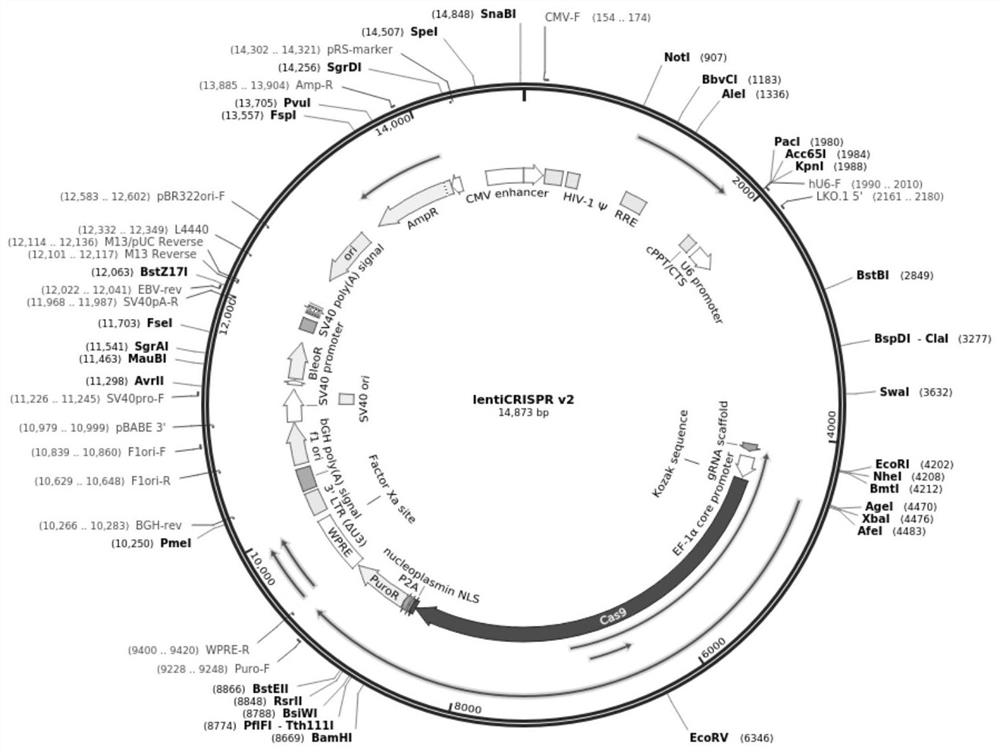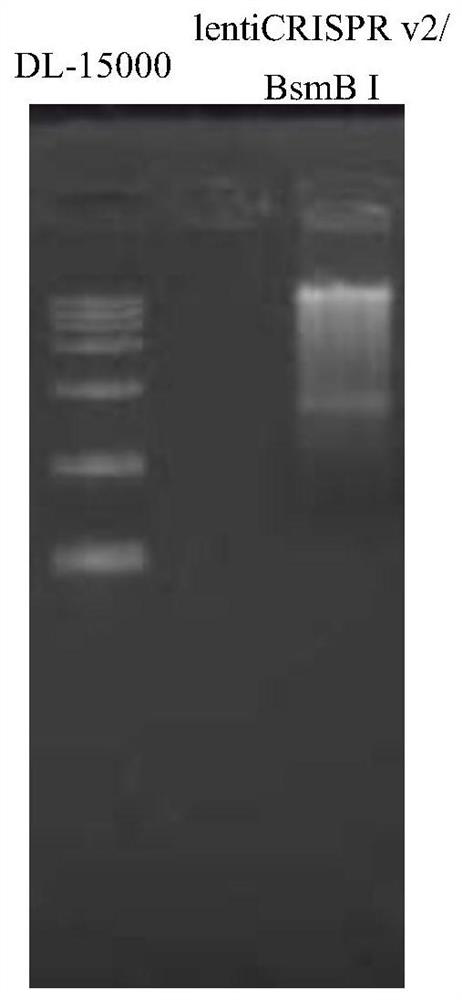Induced inflammatory carcinoma transformation mouse model and its establishment method and application
A mouse model and mouse technology, applied in chemical instruments and methods, biochemical equipment and methods, applications, etc., can solve the problems of living mouse models for a long time, shorten the time of tumor formation, promote liver tumor formation, The effect of improving modeling efficiency
- Summary
- Abstract
- Description
- Claims
- Application Information
AI Technical Summary
Problems solved by technology
Method used
Image
Examples
Embodiment 1
[0039] Example 1: Construction of lentiviral recombinant plasmids knocking out tumor suppressor genes pten and p53 in mice
[0040] 1.1. Use restriction endonuclease BsmBI to lentiCRISPR v2 vector ( figure 1 The map of the vector is shown), and it is linearized and used as a backbone vector for constructing a lentiviral recombinant plasmid knocking out tumor suppressor genes pten and p53 in mice; the restriction enzyme digestion conditions are: under the condition of 55 ℃ After the digestion reaction for 15 minutes, the enzyme was inactivated at 80°C for 20 minutes, and the digestion product was subjected to 1% agarose electrophoresis, and the results were as follows figure 2 As shown, it can be seen that there is a band at 2kb, that is, the target linearized lentiCRISPR v2 vector is obtained, and the target vector band is recovered and stored at -20°C for future use.
[0041] Table 1: The restriction endonuclease BsmBI digests the lentiCRISPRv2 vector
[0042]
[0043] ...
Embodiment 2
[0053] Example 2: Construction of a mouse model of induced inflammatory carcinoma transformation
[0054] In this example, the lentiCRISPR-sgPten lentivirus recombinant plasmid lentiCRISPR-sgPten knocking out the tumor suppressor gene p5 in mice, the lentiCRISPR-sgP53 lentivirus recombinant plasmid lentiCRISPR-sgP53 knocking out the tumor suppressor gene p53 in mice, and Sleeping Beauty The transposase expression plasmid pCMV / SB10, the recombinant plasmid pT3-EF1a-c-met overexpressing the c-met gene, and the recombinant plasmid pT3-N90-β-catenin overexpressing the Δ90-β-catein gene (all the latter three were purchased) from addgene companies such as Figure 3 to Figure 5 , respectively show the maps of the three plasmids. After enrichment, the plasmids were extracted in large quantities, and stored at -20°C for later use) to establish a mouse liver cancer model, which specifically included the following operations: using the hydrodynamic gene transfection method, through C57BL...
Embodiment 3
[0058] Example 3. Verification of the formation of a mouse model of induced inflammatory carcinoma transformation
[0059] After the 7th week of transfection (ie 6 weeks later), the mice were sacrificed to observe the tumor formation in the liver of the mice. The mice in the experimental group were transfected with pCMV / SB10 (5μg), pT3-EF1a-c-met (10μg), pT3 - Mixed plasmids of N90-β-catenin (10μg), lentiCRISPR-sgPten (10μg) and lentiCRISPR-sgP53 (10μg), control mice were transfected with lentiCRISPRv2 (20μg) and pCMV / SB10 (5μg) plasmids, HE staining method Observe the pathological changes of mouse liver:
[0060] (1) Take mouse liver tissue samples with a thickness of about 3 mm, dehydrate them with gradient alcohol for 70%, 80%, 95%, and 100% for 30 minutes each, two bottles of xylene for 20 minutes each, and two tanks of paraffin immersion for 12 minutes each. Sectioned after paraffin embedding, the thickness is about 4 μm.
PUM
| Property | Measurement | Unit |
|---|---|---|
| thickness | aaaaa | aaaaa |
Abstract
Description
Claims
Application Information
 Login to View More
Login to View More - R&D
- Intellectual Property
- Life Sciences
- Materials
- Tech Scout
- Unparalleled Data Quality
- Higher Quality Content
- 60% Fewer Hallucinations
Browse by: Latest US Patents, China's latest patents, Technical Efficacy Thesaurus, Application Domain, Technology Topic, Popular Technical Reports.
© 2025 PatSnap. All rights reserved.Legal|Privacy policy|Modern Slavery Act Transparency Statement|Sitemap|About US| Contact US: help@patsnap.com



